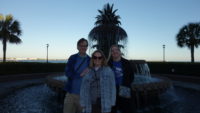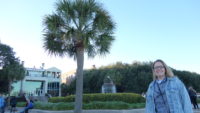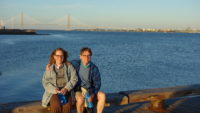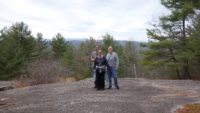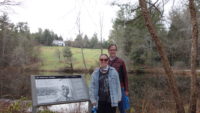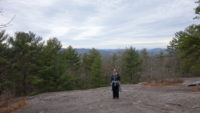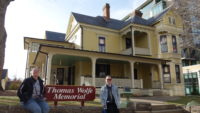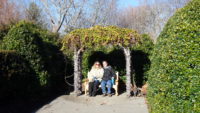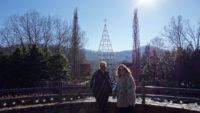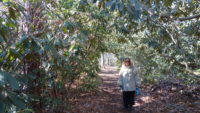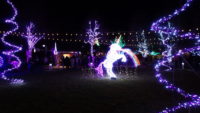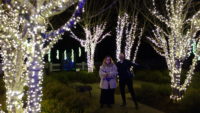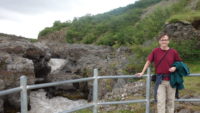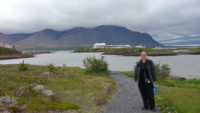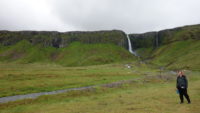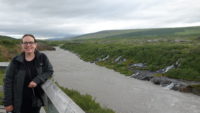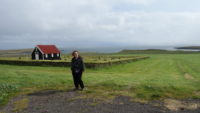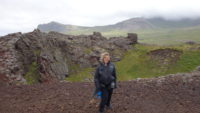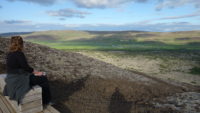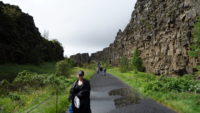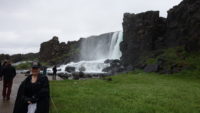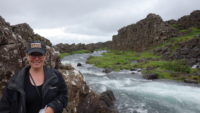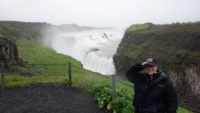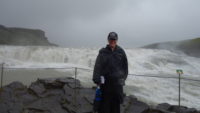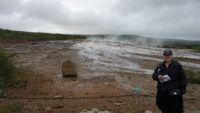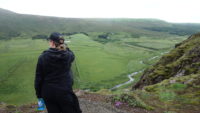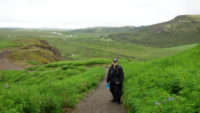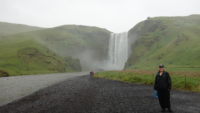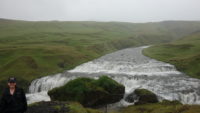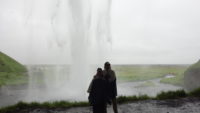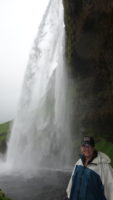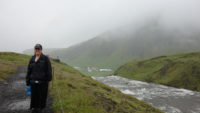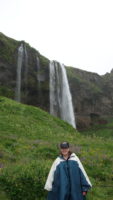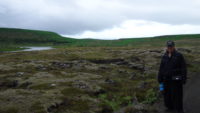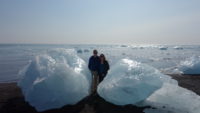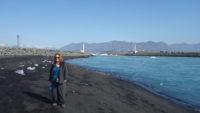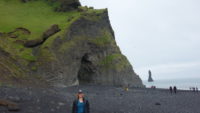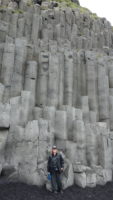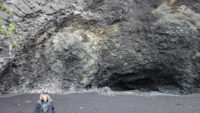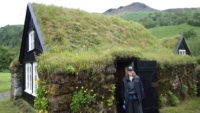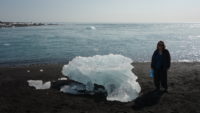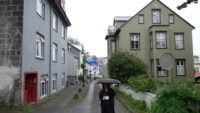 All cold things must come to an end, and so today was our last full touring day in Iceland, with our exploring the capital city, Reykjavik. Weather was again an issue today, with misting rain in the late morning turning to steady rain by early afternoon. And in the late afternoon and evening, when the rain had stopped, we were met with twenty-five-mile-an-hour winds which cut through my three layers of clothing enough to make me uncomfortable. Still, the touring must go on, for we have no touring tomorrow!
All cold things must come to an end, and so today was our last full touring day in Iceland, with our exploring the capital city, Reykjavik. Weather was again an issue today, with misting rain in the late morning turning to steady rain by early afternoon. And in the late afternoon and evening, when the rain had stopped, we were met with twenty-five-mile-an-hour winds which cut through my three layers of clothing enough to make me uncomfortable. Still, the touring must go on, for we have no touring tomorrow!
Meredith is a big fan of Rick Steves’ tour books, and for major cities, he usually has what we term a “Rick Walk.” Rick starts you somewhere in the city and walks you along interesting streets to see the major sights that are within walking distance of each other. There was one of those for Reykjavik, so that was how we spent the late morning and early afternoon.
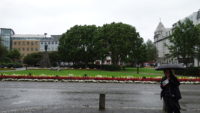 The walk started down by the old harbor in a small square where people think the first settler of Iceland built his farm about eleven hundred years ago. Archaeologists have found evidence of a farm near that area dating from the right period, so it seems a good guess. From there we wandered through a back alley of a residential area. Reykjavik has about 130,000 people, so it’s a little smaller than Akron (at 190,000). It’s hard to imagine being in the main downtown part of Akron and wandering one block away to find cute little houses, but I guess that is what happens when you take one thousand years to grow to a city.
The walk started down by the old harbor in a small square where people think the first settler of Iceland built his farm about eleven hundred years ago. Archaeologists have found evidence of a farm near that area dating from the right period, so it seems a good guess. From there we wandered through a back alley of a residential area. Reykjavik has about 130,000 people, so it’s a little smaller than Akron (at 190,000). It’s hard to imagine being in the main downtown part of Akron and wandering one block away to find cute little houses, but I guess that is what happens when you take one thousand years to grow to a city.
We got to see city hall, situated on a small, pretty pond; given the wind and the rain, we passed on the mile-long walk around the pond. We went on to the Alpingi parliament building where the sixty-three members meet. There is a very lovely park with flowers just outside the building where it would be pleasant to sit on nice days. The chairs were empty today, but the space was still nice.
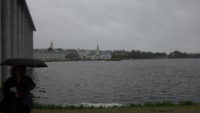
When we got to the start of the modern main street around 11:30, we headed back to the car. Meredith wanted to go somewhere else, and as the precipitation was now a full and steady rain, I was happy to oblige. We both knew that the forecast had the weather clearing up around 3:00, so we could come back later.
We didn’t have a GPS (ours won’t download the Iceland map because the format changed), and we don’t have functional cell phones to use as a GPS, so this whole trip has been old-school – maps, sometimes supplemented by Google directions. Mer had looked up where we were going on Google, so even though it was off all of our maps, we headed out. On trips, we take turns being in charge on different days, and we generally don’t tell the other person what we’ve planned; because this was Mer’s day, I wasn’t sure what our destination would be, but Mer said it wouldn’t be too far away.
After driving for awhile, we saw an exit with a name that might have been an abbreviation of the road we were looking for. We drove on for a bit, and then decided to turn around. This is never easy in Iceland. I think Icelanders have designed roads for traffic flow at the cost of all other considerations. This means that if you see, say, a gas station off of a main road, there will rarely be access to the gas station from said main road. You are expected to know on which side road to get off to get to the entrance. Making turning around even harder is the fact that many main roads dump onto other main roads which dump onto other main roads which have no left turns into the only driveway on the west coast.
We eventually did manage to turn around and went back the other way looking for the exit. We never saw it. So we had to manage another turnaround. The exit turned out to be only on one side of the main road. Fair enough. We got off on the new road, which didn’t look right, since it dumped us into a rotary and the real road was supposed to be a merge instead. We saw a gas station, so we thought we would ask there. I turned into the driveway of the gas station, only to be directed on a one-way street back onto the highway.
We turned around again and repeated the process, this time finding the elusive way in. The clerk behind the counter was very helpful and drew us a map. Off we went. Another challenge to driving in Reykjavik is that you have to decide which turn lane to be in well before you can see any street signs. We got the right street, going the wrong way. Execute difficult turnaround procedure. We got to the next right street, going the wrong way. Execute difficult turnaround procedure. We finally got to our destination, which was a block of apartment buildings. I admit that I was stumped.
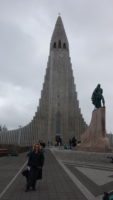
Meredith had found a house church to go to. It’s a church plant, but the “plant” part of the church was interrupted by Covid, so they have been meeting virtually and as a small group, waiting for when they can actually open a building. The church pastor and his wife are both Americans who felt that God was calling them to minister in Iceland, and so the service was in English. There were fourteen of us – mostly Americans, with a couple of Germans, an Icelander, and one or two people whose nationality I didn’t catch.
It was a good service, and it was good to be back in a church gathering again after two weeks on the road. The pastor spoke on Psalm 96 and how worship is a lifestyle and not just what we do on Sundays, and also a call to mission activity to those around us. We sang two hymns and said the Apostles’ Creed and took communion. Meredith and I hung around after the service for about thirty minutes, chatting mostly with the pastor.
After church, it was back into the city, where the rain had stopped. We started with going to a donut shop the pastor had recommended. It was a good recommendation. We then walked back to pick up the Rick Walk from where we had left off.
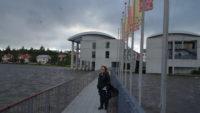 It basically took us up the main shopping drag/tourist gauntlet, up the hill to the city’s iconic church. The church façade is designed to look like basalt columns, which works well. The inside of the church is unadorned – clear glass windows and no decoration of any kind (other than one corner chapel where there is a painting of the Madonna and child, which was surprising to me to find in a Lutheran church). The interior’s simplicity is harmonious and makes for a reverent atmosphere. Which was broken by a man shouting, “We are closing!” It was 5:00, and so we had just made it into the church with only about ten minutes to spare.
It basically took us up the main shopping drag/tourist gauntlet, up the hill to the city’s iconic church. The church façade is designed to look like basalt columns, which works well. The inside of the church is unadorned – clear glass windows and no decoration of any kind (other than one corner chapel where there is a painting of the Madonna and child, which was surprising to me to find in a Lutheran church). The interior’s simplicity is harmonious and makes for a reverent atmosphere. Which was broken by a man shouting, “We are closing!” It was 5:00, and so we had just made it into the church with only about ten minutes to spare.
From the church, we went down a side street into a sculpture garden. An Icelandic artist had made a deal with the Alpingi that if they built him a house and studio, he would leave all future work to the people. They did, and he did, so there are about twenty or thirty sculptures from around 1910 to 1950 in the garden, drawing on Icelandic myths and sagas and also bringing in aspects of Christianity. Most of the sculptures focused on only two or three figures, and so felt very intimate. It was in a walled-off garden, so not only was it peaceful, but it shielded us from the wind as well. I loved it.
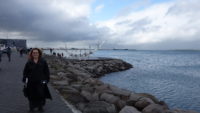 From the garden, we walked down to the harbor to see the famous sculpture Sun Voyager. That was within easy walking distance of the opera house, which was finished about 2010 and critically well-received, even if some locals were critical of the cost. We got back to the general area of the car, which coincidently was parked next to the city’s Icelandic Phallological Museum; thus I was able to point it out to an older lady who was asking people for directions to it. I wasn’t going to judge her for going as long as she didn’t ask me how I knew so quickly where it was.
From the garden, we walked down to the harbor to see the famous sculpture Sun Voyager. That was within easy walking distance of the opera house, which was finished about 2010 and critically well-received, even if some locals were critical of the cost. We got back to the general area of the car, which coincidently was parked next to the city’s Icelandic Phallological Museum; thus I was able to point it out to an older lady who was asking people for directions to it. I wasn’t going to judge her for going as long as she didn’t ask me how I knew so quickly where it was.
Mer decided to extend the walk a bit by going back to look at the pond at city hall now that the rain had stopped. When we got there, we both laughed at how the small pond had actual one-foot waves on it from the gusting wind. We took that as a sign to go get dinner back by the hotel. The restaurant Meredith wanted to go to was closed for the owner being on vacation, so we settled for the very un-Icelandic solution of Subway instead. At least Meredith was able to try corn on her sandwich, and so it felt a little exotic.
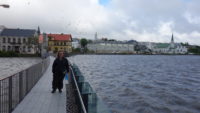 And so closed the Iceland touring. Back in the hotel, we repacked everything and got as ready for tomorrow as we could. We will aim to be up by 5:30 to be at the airport at 8:00 to return the car – if you go over even a little on another day, you get charged the full $120 for the extra time. Our flight leaves at 11:20, and we get back to Newark around 1:30 local time. It will be good to get home and see family, friends, and kitties, as well as get back to a routine. Touring Europe is exciting and tiring at the same time. Home is where the purr is.
And so closed the Iceland touring. Back in the hotel, we repacked everything and got as ready for tomorrow as we could. We will aim to be up by 5:30 to be at the airport at 8:00 to return the car – if you go over even a little on another day, you get charged the full $120 for the extra time. Our flight leaves at 11:20, and we get back to Newark around 1:30 local time. It will be good to get home and see family, friends, and kitties, as well as get back to a routine. Touring Europe is exciting and tiring at the same time. Home is where the purr is.
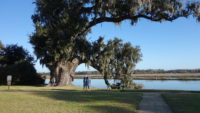 Poor Meredith was in charge today, and she did her research. Despite that, the places she wanted to go for breakfast, supper, and dessert were all unexpectedly closed (despite what their websites said). But I still managed to have a very southern day, with biscuits, chicken, and pralines on my menu for the day.
Poor Meredith was in charge today, and she did her research. Despite that, the places she wanted to go for breakfast, supper, and dessert were all unexpectedly closed (despite what their websites said). But I still managed to have a very southern day, with biscuits, chicken, and pralines on my menu for the day.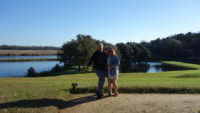 The original plantation was huge – over ten square miles, and after trying several crops that didn’t pan out, the owner finally settled on rice, which grew very well and made the already wealthy Middletons even richer. Rice is a labor-intensive crop, so the plantation had at least one hundred slaves on the property. The historical placards around the grounds tried to give as much information on the enslaved population as historians have been able to uncover, as well as trying to cover the Middletons themselves and how rice was grown in the area.
The original plantation was huge – over ten square miles, and after trying several crops that didn’t pan out, the owner finally settled on rice, which grew very well and made the already wealthy Middletons even richer. Rice is a labor-intensive crop, so the plantation had at least one hundred slaves on the property. The historical placards around the grounds tried to give as much information on the enslaved population as historians have been able to uncover, as well as trying to cover the Middletons themselves and how rice was grown in the area.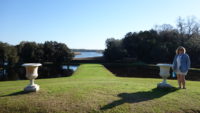 The showstopper sight is the line where the main house used to stand (it was burned down at the end of the Civil War). The house looked over a long lawn that went down terraced grounds to two reflecting ponds that led the eye through the trees to the river that flowed in a line away from the house. And even in late December, there were still blooming shrubs and flowers about.
The showstopper sight is the line where the main house used to stand (it was burned down at the end of the Civil War). The house looked over a long lawn that went down terraced grounds to two reflecting ponds that led the eye through the trees to the river that flowed in a line away from the house. And even in late December, there were still blooming shrubs and flowers about. n addition to the self-guided tour of the grounds, we caught three guided tours – one on slaves on the plantation, one on the animals of the estate, and one on the history of the gardens themselves. Mer and I do love guided tours for the personal storytelling style they have.
n addition to the self-guided tour of the grounds, we caught three guided tours – one on slaves on the plantation, one on the animals of the estate, and one on the history of the gardens themselves. Mer and I do love guided tours for the personal storytelling style they have.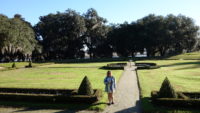 It was a perfect day, weather-wise, with lots of sun and temperatures in the seventies. The grounds had lots of shade, including many live oaks, which have huge canopies of leaves. So we were never hot, but enjoyed the warmth very much this late in the year.
It was a perfect day, weather-wise, with lots of sun and temperatures in the seventies. The grounds had lots of shade, including many live oaks, which have huge canopies of leaves. So we were never hot, but enjoyed the warmth very much this late in the year.